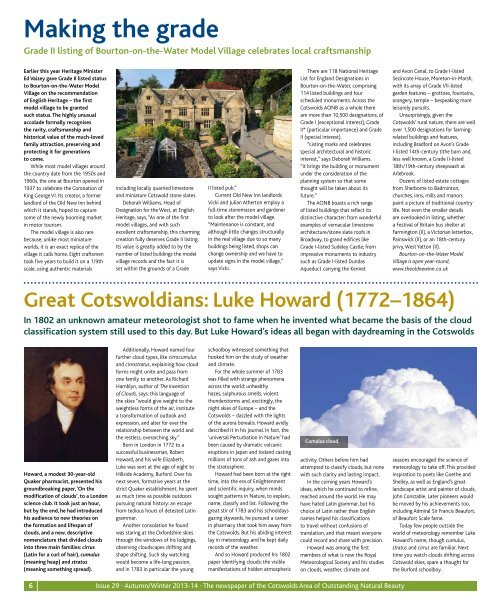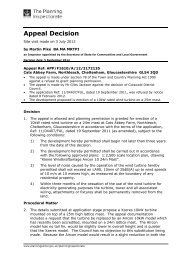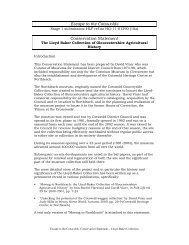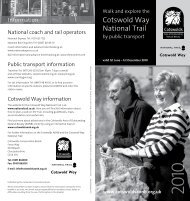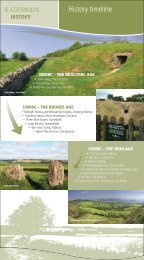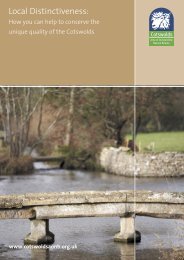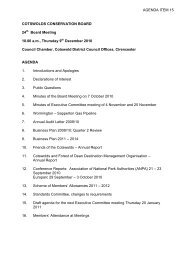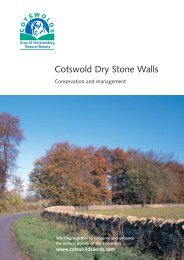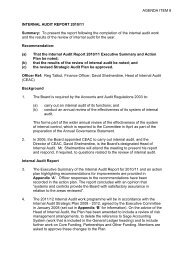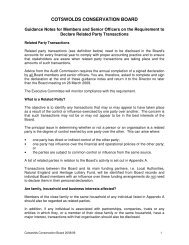Autumn/Winter Cotswold Lion - Cotswolds Area of Outstanding ...
Autumn/Winter Cotswold Lion - Cotswolds Area of Outstanding ...
Autumn/Winter Cotswold Lion - Cotswolds Area of Outstanding ...
Create successful ePaper yourself
Turn your PDF publications into a flip-book with our unique Google optimized e-Paper software.
Making the gradeGrade II listing <strong>of</strong> Bourton-on-the-Water Model Village celebrates local craftsmanshipEarlier this year Heritage MinisterEd Vaizey gave Grade II listed statusto Bourton-on-the-Water ModelVillage on the recommendation<strong>of</strong> English Heritage – the firstmodel village to be grantedsuch status. The highly unusualaccolade formally recognisesthe rarity, craftsmanship andhistorical value <strong>of</strong> the much-lovedfamily attraction, preserving andprotecting it for generationsto come.While most model villages aroundthe country date from the 1950s and1960s, the one at Bourton opened in1937 to celebrate the Coronation <strong>of</strong>King George VI. Its creator, a formerlandlord <strong>of</strong> the Old New Inn behindwhich it stands, hoped to capturesome <strong>of</strong> the newly booming marketin motor tourism.The model village is also rarebecause, unlike most miniatureworlds, it is an exact replica <strong>of</strong> thevillage it calls home. Eight craftsmentook five years to build it on a 1/9thscale, using authentic materialsincluding locally quarried limestoneand miniature <strong>Cotswold</strong> stone slates.Deborah Williams, Head <strong>of</strong>Designation for the West, at EnglishHeritage, says, “As one <strong>of</strong> the firstmodel villages, and with suchexcellent craftsmanship, this charmingcreation fully deserves Grade II listing.Its value is greatly added to by thenumber <strong>of</strong> listed buildings the modelvillage records and the fact it isset within the grounds <strong>of</strong> a GradeII listed pub.”Current Old New Inn landlordsVicki and Julian Atherton employ afull-time stonemason and gardenerto look after the model village.“Maintenance is constant, andalthough little changes structurallyin the real village due to so manybuildings being listed, shops canchange ownership and we have toupdate signs in the model village,”says Vicki.There are 118 National HeritageList for England Designations inBourton-on-the-Water, comprising114 listed buildings and fourscheduled monuments. Across the<strong>Cotswold</strong>s AONB as a whole thereare more than 10,500 designations, <strong>of</strong>Grade I (exceptional interest), GradeII* (particular importance) and GradeII (special interest).“Listing marks and celebratesspecial architectural and historicinterest,” says Deborah Williams.“It brings the building or monumentunder the consideration <strong>of</strong> theplanning system so that somethought will be taken about itsfuture.”The AONB boasts a rich range<strong>of</strong> listed buildings that reflect itsdistinctive character: from wonderfulexamples <strong>of</strong> vernacular limestonearchitecture/stone slate ro<strong>of</strong>s inBroadway, to grand edifices likeGrade I-listed Sudeley Castle; fromimpressive monuments to industrysuch as Grade I-listed DundasAqueduct carrying the Kennetand Avon Canal, to Grade I-listedSezincote House, Moreton-in-Marsh,with its array <strong>of</strong> Grade I/II-listedgarden features – grottoes, fountains,orangery, temple – bespeaking moreleisurely pursuits.Unsurprisingly, given the<strong>Cotswold</strong>s’ rural nature, there are wellover 1,500 designations for farmingrelatedbuildings and features,including Bradford on Avon’s GradeI-listed 14th-century tithe barn and,less well known, a Grade II-listed18th/19th-century sheepwash atArlebrook.Dozens <strong>of</strong> listed estate cottagesfrom Sherborne to Badminton,churches, inns, mills and manorspaint a picture <strong>of</strong> traditional countrylife. Not even the smaller detailsare overlooked in listing, whethera Festival <strong>of</strong> Britain bus shelter atFarmington (II), a Victorian letterbox,Painswick (II), or an 18th-centuryprivy, West Yatton (II).Bourton-on-the-Water ModelVillage is open year-round,www.theoldnewinn.co.ukGreat <strong>Cotswold</strong>ians: Luke Howard (1772–1864)In 1802 an unknown amateur meteorologist shot to fame when he invented what became the basis <strong>of</strong> the cloudclassification system still used to this day. But Luke Howard’s ideas all began with daydreaming in the <strong>Cotswold</strong>sHoward, a modest 30-year-oldQuaker pharmacist, presented hisgroundbreaking paper, ‘On themodification <strong>of</strong> clouds’, to a Londonscience club. It took just an hour,but by the end, he had introducedhis audience to new theories onthe formation and lifespan <strong>of</strong>clouds, and a new, descriptivenomenclature that divided cloudsinto three main families: cirrus(Latin for a curl <strong>of</strong> hair), cumulus(meaning heap) and stratus(meaning something spread).Additionally, Howard named fourfurther cloud types, like cirrocumulusand cirrostratus, explaining how cloudforms might unite and pass fromone family to another. As RichardHamblyn, author <strong>of</strong> The Invention<strong>of</strong> Clouds, says: this language <strong>of</strong>the skies “would give weight to theweightless forms <strong>of</strong> the air, institutea transformation <strong>of</strong> outlook andexpression, and alter for ever therelationship between the world andthe restless, overarching sky.”Born in London in 1772 to asuccessful businessman, RobertHoward, and his wife Elizabeth,Luke was sent at the age <strong>of</strong> eight toHillside Academy, Burford. Over hisnext seven, formative years at thestrict Quaker establishment, he spentas much time as possible outdoorspursuing natural history: an escapefrom tedious hours <strong>of</strong> detested Latingrammar.Another consolation he foundwas staring at the Oxfordshire skiesthrough the windows <strong>of</strong> his lodgings,observing cloudscapes drifting andshape shifting. Such sky watchingwould become a life-long passion,and in 1783 in particular the youngschoolboy witnessed something thathooked him on the study <strong>of</strong> weatherand climate.For the whole summer <strong>of</strong> 1783was filled with strange phenomenaacross the world: unhealthyhazes, sulphurous smells, violentthunderstorms and, excitingly, thenight skies <strong>of</strong> Europe – and the<strong>Cotswold</strong>s – dazzled with the lights<strong>of</strong> the aurora borealis. Howard avidlydescribed it in his journal. In fact, the‘universal Perturbation in Nature’ hadbeen caused by dramatic volcaniceruptions in Japan and Iceland castingmillions <strong>of</strong> tons <strong>of</strong> ash and gases intothe stratosphere.Howard had been born at the righttime, into the era <strong>of</strong> Enlightenmentand scientific inquiry, when mindssought patterns in Nature, to explain,name, classify and list. Following thegreat stir <strong>of</strong> 1783 and his schooldaysgazing skywards, he pursued a careerin pharmacy that took him away fromthe <strong>Cotswold</strong>s. But his abiding interestlay in meteorology and he kept dailyrecords <strong>of</strong> the weather.And so Howard produced his 1802paper identifying clouds: the visiblemanifestations <strong>of</strong> hidden atmosphericCumulus cloud.activity. Others before him hadattempted to classify clouds, but nonewith such clarity and lasting impact.In the coming years Howard’sideas, which he continued to refine,reached around the world. He mayhave hated Latin grammar, but hischoice <strong>of</strong> Latin rather than Englishnames helped his classificationsto travel without confusions <strong>of</strong>translation, and that meant everyonecould record and share with precision.Howard was among the firstmembers <strong>of</strong> what is now the RoyalMeteorological Society and his studieson clouds, weather, climate andseasons encouraged the science <strong>of</strong>meteorology to take <strong>of</strong>f. This providedinspiration to poets like Goethe andShelley, as well as England’s greatlandscape artist and painter <strong>of</strong> clouds,John Constable. Later pioneers wouldbe moved by his achievements too,including Admiral Sir Francis Beaufort,<strong>of</strong> Beaufort Scale fame.Today few people outside theworld <strong>of</strong> meteorology remember LukeHoward’s name, though cumulus,stratus and cirrus are familiar. Nexttime you watch clouds drifting across<strong>Cotswold</strong> skies, spare a thought forthe Burford schoolboy.6Issue 29


